What is a one-on-one meeting
A one-on-one meeting (1 on 1 meeting) is a meeting between two individuals, typically a supervisor and a direct report, where they have a private conversation to discuss work-related matters. This type of meeting is usually scheduled regularly, such as weekly or monthly, and allows for open communication, feedback, and alignment between the two parties. One-on-one meetings provide an opportunity to discuss progress, address any challenges or concerns, set goals, provide guidance and support, and build a strong working relationship. It is a time for both parties to share updates, ask questions, and provide feedback in a more personal and focused setting. These meetings are important for fostering trust, promoting accountability, and ensuring that both parties are aligned and working towards the same objectives.
How to set up a one-to-one team meeting?
Setting up a one-to-one team meeting is a crucial step in promoting effective communication and collaboration within your team. Here are some steps to help you set up a successful one-to-one team meeting.
- Schedule the Meeting: Determine a suitable date and time for the meeting that works for both you and your team member. Consider their availability and any other commitments they may have. It's important to be flexible and accommodating when scheduling the meeting.
- Define the Purpose: Communicate the purpose of the meeting to your team member. Let them know what topics will be discussed and any specific objectives or goals you have for the meeting. This will help them prepare and ensure that the meeting is productive.
- Prepare an Agenda: Create an agenda for the meeting that outlines the topics you plan to discuss. This will provide structure to the meeting and ensure that all important points are covered. Share the agenda with your team members in advance so they can come prepared with any necessary information or questions.
- Choose a Suitable Location: Select a quiet and private location for the meeting where you can have a focused conversation without interruptions. This can be a meeting room, a coffee shop, or even a virtual meeting space if your team member is remote.
- Create a Welcoming Environment: Make your team member feel comfortable and at ease during the meeting. Start by establishing rapport and engaging in some small talk before diving into the agenda topics. This will help build trust and strengthen your working relationship.
- Active Listening: During the meeting, actively listen to your team member's thoughts, concerns, and ideas. Encourage open and honest communication by creating a safe space where they feel comfortable sharing their thoughts. Take notes to demonstrate that you value their input and to ensure that important points are not forgotten.
- Provide Feedback and Support: Offer constructive feedback and guidance to your team member based on their performance or any challenges they may be facing. Use this opportunity to provide support, offer resources, or suggest solutions to any issues discussed during the meeting.
- Set Action Steps and Follow-Up: At the end of the meeting, agree on action steps or next steps to be taken by both you and your team member. Clearly define any deadlines or expectations to ensure accountability. Schedule a follow-up meeting if necessary to check progress or address any outstanding matters.
Remember, the one-to-one team meeting is an opportunity for open dialogue, trust-building, and alignment between you and your team members. By following these steps, you can create a positive and productive environment that fosters collaboration and growth within your team.
Boardmix: one-on-one meeting template online for free
Features of Boardmix one-on-one meeting template
Here are some features of the Boardmix one-on-one meeting template.
1. Customizable Questions: The template allows you to add, edit, and rearrange questions to tailor the meeting agenda according to your needs. This flexibility ensures that you can address specific topics and gather the information you require.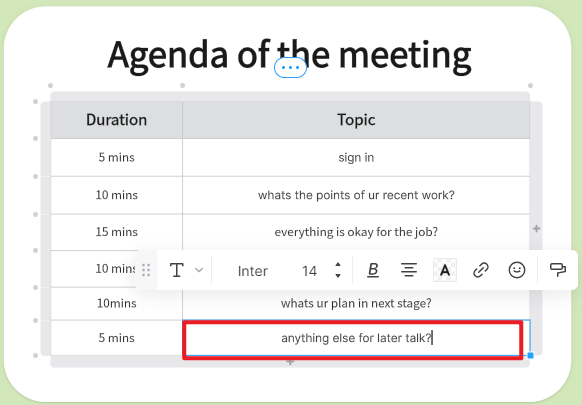
2. Goal Setting: The template includes sections for setting and tracking goals. This feature enables you to align individual goals with team and organizational objectives, fostering a sense of purpose and accountability.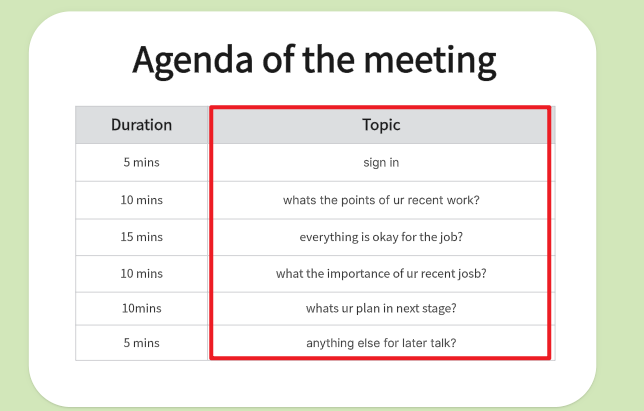
3. Action Items and Follow-ups: The template provides space to record action items and follow-up tasks from previous meetings. This feature helps ensure that important discussions and commitments are documented and followed through.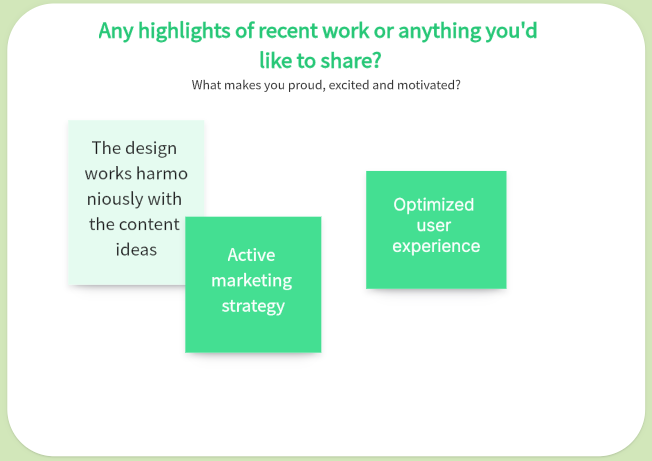
4. Meeting Notes: The template includes a section for capturing meeting notes. This feature allows you to summarize key points, decisions, and outcomes from each meeting, ensuring that everyone is on the same page.
5. Collaboration and Feedback: The template encourages open and honest communication by including sections for discussing challenges, providing feedback, and exploring development opportunities. This feature promotes a collaborative and supportive work environment.
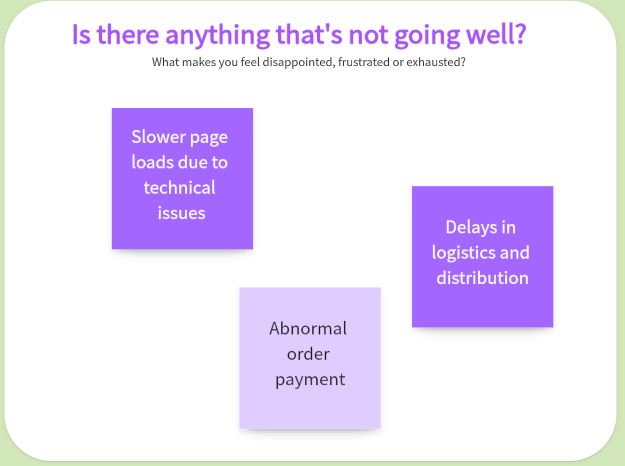
6. Design Customization: Boardmix offers a range of design options for the template, allowing you to personalize its appearance. This feature enables you to align the template with your branding or aesthetic preferences.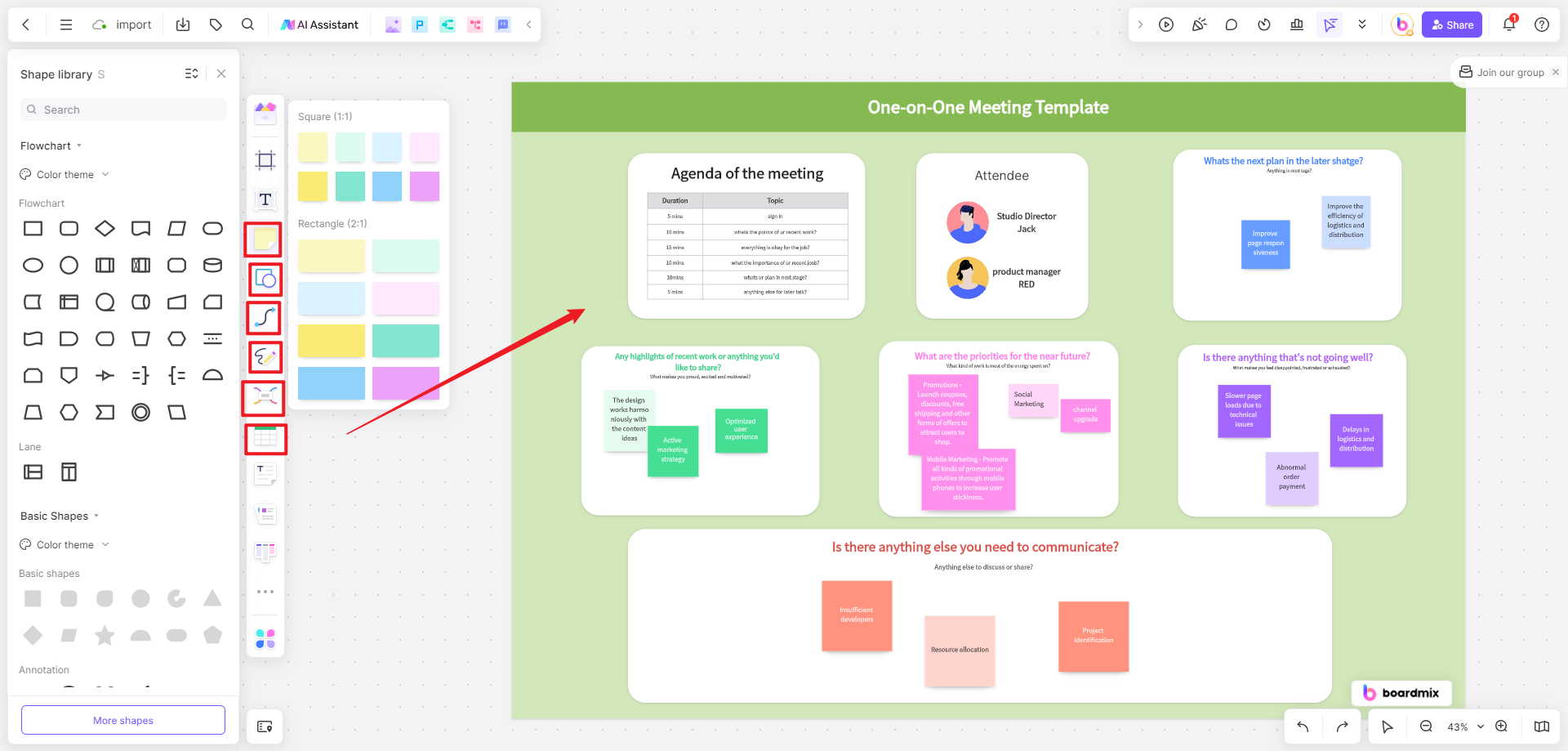
7. Accessibility and Convenience: The Boardmix platform is accessible online, making it easy to access your one-on-one meeting template from anywhere with an internet connection. This feature ensures that you can conveniently refer to and update the template as needed.
8. User-Friendly Interface: Boardmix provides a user-friendly interface that simplifies the process of creating, editing, and using the one-on-one meeting template. This feature ensures a seamless user experience.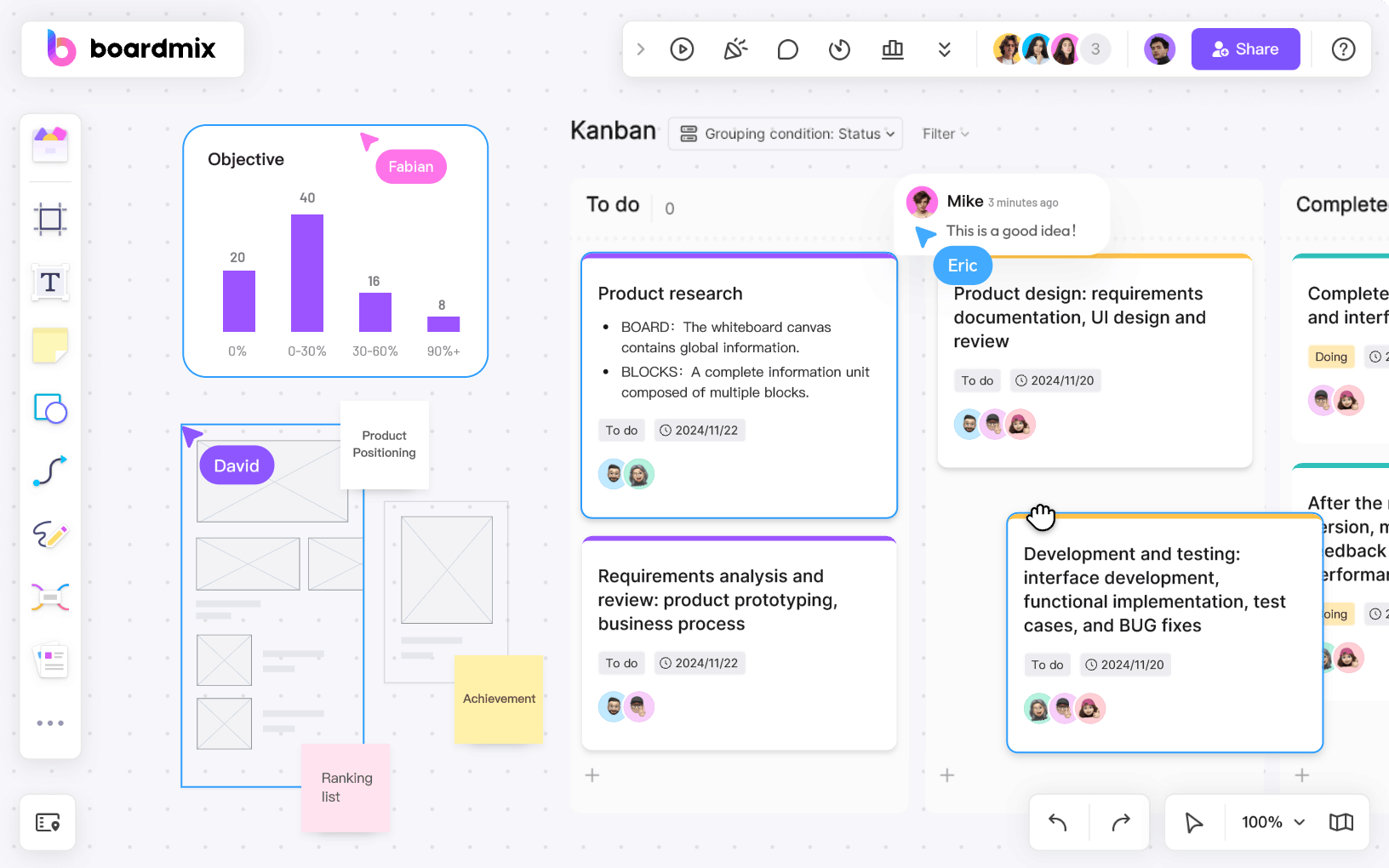
These features make the Boardmix one-on-one meeting template a valuable tool for effective and productive meetings. Whether you're a manager or an employee, this template can help facilitate meaningful discussions, track progress, and drive professional growth.
How to create a one-on-one meeting chart in Boardmix
Creating a one-on-one meeting template online for free can be done through various tools and platforms. Here are the steps to create a template using Boardmix.
- Visit the Boardmix website or download the app from your app store.

- Sign up for a free account or log in if you already have one.

- Once you're logged in, navigate to the templates section.
- Search for "one-on-one meeting" templates or browse through the available options.
- Select a template that suits your needs and click on it to open the editor.
- Customize the template by adding your questions, sections, or prompts. You can also modify the design and layout according to your preferences.
- Save your changes and give your template a name.
- Your one-on-one meeting template is now ready to use. You can access it anytime and use it for your meetings.
Boardmix offers a user-friendly interface and a wide range of customizable templates to help you create professional-looking meeting templates for free. Enjoy your one-on-one meetings with a well-structured and organized template!
What should I cover in a one-to-one meeting?
When conducting a one-to-one meeting, it's important to cover various aspects to ensure effective communication and alignment between you and your team members. Here are some key areas to cover in a one-to-one meeting.
- Progress Updates: Begin the meeting by discussing the progress and status of ongoing projects or tasks. This provides an opportunity to review accomplishments, address any challenges or roadblocks, and ensure everyone is on track.
- Goal Alignment: Discuss individual goals and how they align with team and organizational objectives. This helps in understanding if there are any gaps or overlaps, and allows for adjustments or realignment if needed.
- Performance Evaluation: Provide feedback and evaluate the team member's performance. Recognize achievements, discuss areas for improvement, and set goals for growth and development.
- Professional Development: Discuss opportunities for learning and development. Identify training programs, workshops, or resources that can help enhance skills and knowledge.
- Challenges and Concerns: Create a safe space for the team members to share any challenges or concerns they may have. Listen actively, provide support, and collaborate on finding solutions.
- Career Aspirations: Discuss the team member's long-term career aspirations and goals. This helps in understanding their motivations and ambitions and guides potential career paths within the organization.
- Work-Life Balance: Inquire about their work-life balance and well-being. Discuss any issues or challenges they may be facing in managing their personal and professional lives, and offer support or resources if needed.
- Feedback and Recognition: Provide specific feedback on their strengths and areas for improvement. Recognize their achievements and contributions, as well as any exceptional work they have done.
- Next Steps and Action Plan: Agree on action steps and next steps to be taken by both parties. Set clear expectations, define deadlines if necessary, and schedule follow-up meetings to review progress.
Remember, the one-to-one meeting is an opportunity for open communication, collaboration, and growth. By covering these areas, you can ensure that the meeting is productive, meaningful, and beneficial for both you and your team member.
What are the meaningful one-on-one meeting questions?
Meaningful one-on-one meeting questions can help facilitate deeper conversations and foster a stronger connection between you and your team members. Here are some examples of meaningful one-on-one meeting questions.
- How are you feeling about your workload? Is there anything I can do to support you better?
- What accomplishments are you most proud of since our last meeting?
- Is there anything you're struggling with that we can address together?
- Are there any specific skills or areas you'd like to develop further?
- How can we improve our team collaboration and communication?
- Are there any roadblocks or challenges that are hindering your progress?
- What feedback do you have for me as a manager?
- How do you see yourself growing within the organization in the long term?
- Is there anything I should be aware of regarding your work-life balance or well-being?
- Are there any additional resources or support you need to succeed in your role?
- What are your career aspirations for the next year?
- How can we enhance your job satisfaction and engagement?
- Is there anything you would like to change about your current responsibilities or projects?
- Are there any training opportunities you would like to explore?
- What can I do to create a more inclusive and supportive work environment for you?
- Are there any upcoming deadlines or important tasks I should be aware of?
- How can we promote better work-life balance within our team?
- Are there any ideas or suggestions you have for improving our team's efficiency or productivity?
- What can I do to help you reach your full potential in your role?
- Is there anything else you would like to discuss or address during our meeting?
These questions can help foster open and honest conversations, address concerns, provide support, and align individual goals with team and organizational objectives.
FAQ for 1 on 1 meetings
What is the purpose of a 1 on 1 meeting template?
The purpose of a 1-on-1 meeting template is to provide a structure and framework for conducting effective and productive 1-on-1 meetings. It serves as a guide for both the manager and the employee to ensure that important topics are discussed, goals are aligned, and any concerns or issues are addressed. The template typically includes sections for agenda items, goal setting, progress updates, challenges or obstacles, and action plans. Using a template, both parties can come prepared and make the most of their time together. It also helps to create a consistent and structured approach to 1-on-1 meetings across the organization.
How long is a 1 on 1 meeting?
The length of a 1-on-1 meeting can vary depending on the needs and preferences of the individuals involved. However, it is generally recommended to allocate at least 30 minutes to an hour for a productive and meaningful 1-on-1 meeting. This timeframe allows enough time for both parties to discuss important topics, address any concerns, and establish action plans. It's important to prioritize quality over quantity in these meetings, ensuring that there is sufficient time for open communication and effective problem-solving.
How do I prepare for a 1 on 1 with my boss?
Preparing for a 1-on-1 meeting with your boss is essential to make the most out of the meeting. Here are some tips to help you prepare:
- Review your goals and priorities
- Prepare a list of discussion topics
- Gather relevant information
- Anticipate potential questions or concerns
- Reflect on your achievements and challenges
- Take notes during the meeting








